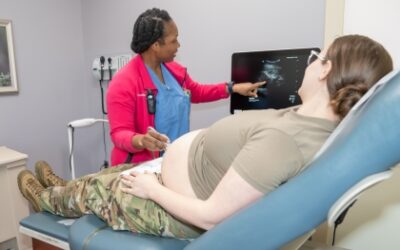A study found that TARC levels measured in pre-diagnostic serum samples had notably increased values in most patients up to over six years before diagnosis.
Lymphoma Most-Common Cancer Diagnosed in Active-Duty Military Personnel
SAN ANTONIO –Active-duty servicemembers diagnosed with lymphoma within the MHS had better overall survival than a matched civilian cohort, but the authors of a study with that finding emphasized that more information is needed to ensure optimal treatment for those...
VA Will Assess Leukemias, Multiple Myeloma as Presumptive Service Conditions
In what could be the first conditions added to the new PACT Act, the VA is conducting a scientific review to determine any relationship between three conditions—acute leukemias, chronic leukemias, and multiple myeloma outside of the head and neck—and toxic exposures for servicemembers who deployed to Iraq, Afghanistan, Somalia, Djibouti, Egypt, Jordan, Lebanon, Syria, Yemen, Uzbekistan, and the entire Southwest Asia theater of operations.
Veteran Firearm Owners Support Some Safety Counseling in Clinical Settings
Most U.S. veterans who own firearms believe that clinicians should discuss firearm safety, if the patient or the patient’s family members are at increased risk of firearm injury, according to a recent study.
Women Serving in Gulf War Demonstrated Worse Health Outcomes Than Others
Women veterans who deployed to the 1990-1991 Gulf War report poorer health than Gulf War Era veterans who served during that time but didn’t deploy and women in the U.S. general population, according to a recent study.
Flexible Prevention Bundle Appears to Reduce Some Surgical Site Infections
Surgical site infections (SSIs) are associated with significant morbidity and mortality, prolonged length of hospital stay and readmission.
Statins Affect Coronary Artery Calcium Score Used to Determine CVD Risk
A retrospective study involving more than 1,000 U.S. veterans has called into question the use of a coronary artery calcium score (CACS) to assess risk of atherosclerosis.
Overestimation of Oxygen Saturation Delayed COVID-19 Care, Despite Race
The overestimation of oxygen saturation by pulse oximetry in patients led to the delay of COVID-19 treatment and potentially increased hospital readmissions, according to a new study.
Rheumatoid Arthritis Raises the Risk of Aortic Stenosis Development
For rheumatoid arthritis patients, cardiovascular disease (CVD) is the most frequent cause of death and leads to much of the excess mortality associated with the condition.
Real-World Prognostic Data for Radiation Therapy in Localized Prostate Cancer
Accurate information regarding treatment outcomes after radiation therapy for localized prostate cancer is important for shared decision-making.
Diabetes Has Surprising Effect on Prostate Cancer Prognosis
How diabetes affects the prognosis of advanced prostate cancer (PC) is not well documented, according to a new study which sought to provide more information.
Mast Cell Depletion Affects Prostate Cancer Progression
Better understanding of the cellular immune components underlying aggressive prostate cancer, especially among African American (AA) men who are disproportionately affected by the disease compared with white men, could help improve precision medicine treatment strategies, according to a new study.
Agent Orange Appears to Be Prostate Cancer Risk Factor
Agent Orange exposure appears to be an independent risk factor for a prostate cancer (PCa) diagnosis, although it remains unclear how Vietnam veterans exposed to the defoliant fare when it comes to metastasis or mortality.
Lower Risks of Adverse Effects in Older Adults With Moderna COVID-19 Vaccine
Receipt of the Moderna COVID-19 vaccine by older adults was associated with a lower risk of adverse events than the Pfizer-BioNTech version, according to a new study.
Surgery for Cervical Disc Disease Can Be Safely Performed in Overseas MTFs
Surgical procedures for cervical degenerative disc disease, including anterior cervical discectomy and fusion (ACDF) or cervical disc arthroplasty (CDA), are safe and effective therapies for active duty servicemembers in overseas military medical facilities, according to a recent study.
Oral Cancer Patients Have Higher Risk of Death From Other Causes
Patients with oral cancer have a higher risk of death from noncancer causes compared to their counterparts of the same age and sex, and this risk increases by stage, according to a recent study.
American Indian/Alaska Native Veterans Had Less Access to Mental Telehealthcare
The American Indian/Alaskan Native population has traditionally experienced more serious health issues and barriers to healthcare compared to those of other races or ethnicities.
Molnupiravir’s Benefit Limited for Severe COVID-19 Outcomes in Veterans
Molnupiravir, an antiviral medication that is used to treat COVID-19, is not associated with significant clinical benefits, such as preventing hospitalizations or death in veterans with COVID-19, according to a recent study.
Disparities in Heart Failure Persist Despite MHS’s Universal Care Access
Heart failure affects an estimated 6.2 million adults in the United States and is associated with disability, diminished quality of life and a 5-year mortality of 50%.
Recent Lawsuits Challenge In Vitro Fertilization Policies at VA, DoD
A lawsuit filed recently in federal court in Manhattan challenges the eligibility policies of DoD and VA for who can receive in vitro fertilization (IVF) care, calling them discriminatory.
Tixagevimab/Cilgavimab Found Effective in Immunocompromised Veterans
The risk of COVID-19 morbidity and mortality is much higher for immunocompromised patients, and, while vaccines have been highly successful at preventing the spread of SARS-CoV-2 and decreasing the likelihood of severe disease in the general population, those who are immunocompromised still face a greater danger for breakthrough infections and persistent viral replication, according to a new study.
Sooner Is Better for Obscure GI Bleeding Evaluation
Small-bowel evaluation through video-capsule endoscopy (VCE) or double-balloon enteroscopy (DBE) is often necessary to determine the cause of overt obscure gastrointestinal bleeding (OOGIB).
Anemia Raises Dementia Risk in Veterans With CKD
What is the role of anemia in risk of dementia in veterans with chronic kidney disease?
Multiple Myeloma Unusual in Younger Patients, Behaves Differently
Multiple myeloma (MM) is extremely unusual in adolescents and young adults (AYAs) younger than 45, and, when it does occur, often has some unusual features.
Significant Increase in Celiac Disease Found in Military Population
The incidence and prevalence of celiac disease increased significantly in the U.S.
Historical Practice of Redlining Is Linked to Adverse Cardiovascular Events
The historical practice of redlining, where neighborhoods were graded based on racial and ethnic compositions, has left a lasting impact on the health of communities across the United States.
JAK Inhibitors: Effective Oral Treatment For Ulcerative Colitis, Crohn’s Disease
A few months ago, the Food and Drug Administration approved the first JAK Inhibitor for adults with moderately to severely active Crohn’s disease who have had an inadequate response or intolerance to one or more tumor necrosis factor blockers.
VA Is Screening for Breast Cancer in Veterans Under 40 With Toxic Exposures
Veterans younger than age 40 might be eligible for breast cancer risk assessments and mammograms if they were exposed to burn pits and other toxins during their service, according to the VA.
Eight Ways to Lengthen Life From a Recent Study of Veterans
Adopting eight healthy lifestyle habits by middle age can help substantially lengthen life, according to a new study of veterans.
Total Alcohol Abstinence Not Necessary to Benefit From CBT for Insomnia
Patients seeking treatment for insomnia are urged to abstain from alcohol, which is known to disrupt sleep. Sleep disturbances often continue, however, even in those who are abstinent, which decreases the likelihood of treatment completion and increases the risk of relapse.






